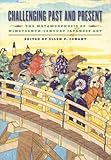Challenging Past and Present : The Metamorphosis of Nineteenth-Century Japanese Art / ed. by Ellen P. Conant.
Material type: TextPublisher: Honolulu : University of Hawaii Press, [2006]Copyright date: ©2006Description: 1 online resource (344 p.) : 45 illus., 15 in colorContent type:
TextPublisher: Honolulu : University of Hawaii Press, [2006]Copyright date: ©2006Description: 1 online resource (344 p.) : 45 illus., 15 in colorContent type: - 9780824829377
- 9780824840594
- online - DeGruyter
- Issued also in print.
| Item type | Current library | Call number | URL | Status | Notes | Barcode | |
|---|---|---|---|---|---|---|---|
 eBook
eBook
|
Biblioteca "Angelicum" Pont. Univ. S.Tommaso d'Aquino Nuvola online | online - DeGruyter (Browse shelf(Opens below)) | Online access | Not for loan (Accesso limitato) | Accesso per gli utenti autorizzati / Access for authorized users | (dgr)9780824840594 |
Frontmatter -- Contents -- Illustrations -- Acknowledgments -- Note on Transliteration -- 1. Introduction: A Historiographical Overview -- Part One. "History" Reviewed and Visualized -- 2. Cultural Change in Nineteenth-Century Japan -- 3. History Painting in the Meiji Era: A Consideration of the Issues -- 4. Mori Ōgai's Phantom Partner: The Development of a Public for Western-style Painting in Meiji Japan -- Part Two. Resituating Yokohama -- 5. Innovational Adaptations: Contacts between Japanese and Western Artists in Yokohama, 1859-1899 -- 6. Expectation and Authenticity in Meiji Tourist Photography -- 7. Gorgeous with Glitter and Gold: Miyagawa Kōzan and the Role of Satsuma Export Ware in the Early Meiji Ceramic Industry -- Part Three. Reconfiguring Painting Traditions -- 8. In Quest of the Real: Portrayal and Photography in Japanese Painting Theory -- 9. Meiji Response to Bunjinga -- 10. The Image of Kannon as Compassionate Mother in Meiji Art and Culture -- Part Four. Architecture and Expositions Intent and Implementation -- 11. Reassessing the Rokumeikan -- 12. Japanese Imperial Architecture: From Thomas Roger Smith to Itō Chūta -- 13. Japan "Abroad" at the Chicago Exposition, 1893 -- Contributors -- Index
restricted access online access with authorization star
http://purl.org/coar/access_right/c_16ec
The complex and coherent development of Japanese art during the course of the nineteenth century was inadvertently disrupted by a political event: the Meiji Restoration of 1868. Scholars of both the preceding Edo (1615-1868) and the succeeding Meiji (1868-1912) eras have shunned the decades bordering this arbitrary divide, thus creating an art-historical void that the former view as a period of waning technical and creative inventiveness and the latter as one threatened by Meiji reforms and indiscriminate westernization and modernization. Challenging Past and Present, to the contrary, demonstrates that the period 1840-1890, as seen progressively rather than retrospectively, experienced a dramatic transformation in the visual arts, which in turn made possible the creative achievements of the twentieth century.The first group of chapters takes as its theme the diverse cultural currents of the transitional period, particularly as they applied to art.The second section deals with the inconsistent yet determinedly pragmatic courses pursed by artists, entrepreneurs, and patrons to achieve a secure footing in the uncertain terrain of early Meiji. Further chapters look at how painters and sculptors sought to absorb and integrate foreign influences and reinterpret their own stylistic mediums.
Issued also in print.
Mode of access: Internet via World Wide Web.
In English.
Description based on online resource; title from PDF title page (publisher's Web site, viewed 02. Mrz 2022)


